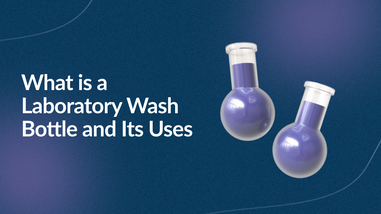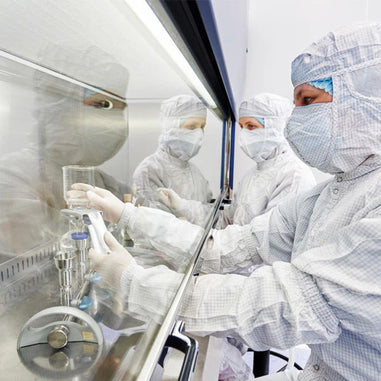- No products in the cart.
While cleaning glassware is one of the more mundane tasks among laboratory workers, maintaining pristine glassware is also among the most important logistical challenges which labs routinely face. Clean glassware is essential for experimentation and for production because glassware is the most fundamental tool that exists in the laboratory. A shoddy cleaning job may lead to failed experiments or anomalous and unreproducible results. Likewise, a shortage of ready-to-use equipment will leave even the most ingenious scientists without any way forward.
Despite how important clean glassware is for the livelihood of most laboratories in chemistry and biology, few labs have a true protocol for cleaning glassware, and practically no two labs which do have a protocol have the same protocol for cleaning glassware. Critically, cleaning glassware doesn’t need to be expensive or time-consuming—but because the task of cleaning is considered too simple to warrant following a protocol, laboratories without a concise glassware cleaning protocol are vulnerable to mishaps which result in overspending and underperforming. Thus, adopting a uniform set of best practices for cleaning glassware can be a surprising source of cost savings and improved scientific rigor.
Common Glassware Contaminants
Developing a protocol for cleaning glassware requires an understanding of the most common contaminants on glassware. The most common contaminants on glassware include:
- Trace liquids
- Trace solids
- Cells and other biological debris
Nonetheless, if glassware is contaminated with any of the above contaminants but passed off as clean to the members of the lab, anomalous results are all but guaranteed, meaning that the type of contaminant is less important than the fact that there are contaminants on the glassware at all. The frequency of encountering each of these contaminants on a lab’s glassware will vary depending on what the lab works with the most frequently. Each contaminant poses specific challenges to the lab staff tasked with cleaning glassware.
Trace liquids include all manner of chemicals ranging from saline or cellular growth media to alcohols, solvents, or acids. The trouble with trace liquids is that when the glassware is washed with another liquid, the trace liquids become mixed with the other liquid. This means that the trace liquids are diluted and partially rinsed away. But, if the rinsing process is incomplete, the trace liquids will likely remain in their diluted form. Then, these liquids will proceed to contaminate the next experiment in which the glassware is used. Overall, most laboratory personnel are aware that trace liquids can contaminate experiments, and so numerous rounds of rinsing are used on each piece of glassware to compensate.

Pictured: Lab Glassware Equipment including Boiling Flasks, Beakers and Erlenmeyer Flask.
In contrast, trace solids are often significantly harder to dislodge than trace liquids. Trace solids include biofilms, caked chemicals, dust, and anything else which may have been introduced to the glassware during the last experiment. These solids are especially pernicious because most personnel expect to see solids with their eyes, but many trace solids are microscopic, nearly invisible, or otherwise extremely difficult to see. Furthermore, repeated rinsing does not necessarily remove trace solids if the wrong chemical is being used or if the rinsing is not accompanied by mechanical force from a cleaning brush. What’s more, trace solids can sometimes compromise the integrity of the glassware if they are left caked on for too long, meaning that they can contribute to glassware attrition.
Cells and biological debris are the easiest forms of glassware contaminants to remove. Most mammalian cells do not adhere strongly to glass in the event that they adhere at all, and so they are easily dislodged with water, a standard detergent cleaning solutions, or solvents. Bacterial cells can and do adhere to glass strongly, but they are just as easy to remove as other cells. Bleach is the go-to weapon against cellular contamination of glassware for most labs, but it’s crucial to recognize that bleach is itself a potent chemical contaminant which can remain behind in trace quantities if the glassware isn’t rinsed methodically.
The Glassware Cleaning Protocol
While the precise needs of each lab will vary somewhat depending on their field and the resources they have available, the fundamental principles of cleaning glassware are universal. First, inactivate anything which might be hazardous or unpredictable during the cleaning process. Then, clean the glassware as completely as possible using a variety of methods. Finally, let the glassware dry somewhere where it won’t become dusty or dirty before the next person uses it.
Thus, most laboratories will be well-served by following this flexible glassware cleaning protocol:
- Conclude the experiment
- Don personal protective equipment (PPE) like goggles, a lab coat, and nitrile gloves
- Stop any ongoing chemical reactions using the correct chemical reagent
- Neutralize any strong acids or bases using the correct chemical reagent
- Stop any ongoing cellular activity by adding bleach to the glassware in a 1:10 dilution and incubating for 60 seconds
- Dispose of the liquid inside of the glassware into the appropriate chemical or biohazard disposal location, not the sink
- Rinse the glassware with 25 mls of acetone or another alcohol-based solvent three times, disposing the runoff of the first rinse into the chemical or biohazard disposal location and the runoff of the other rinses into the sink
- Wash the glassware with 25 mls of a detergent-based cleaning solution while scrubbing the interior of the glassware with a coarse-bristled cleaning brush
- Rinse the glassware liberally with 100 mls of hot tap water three times, disposing the runoff into the sink
- Rinse the glassware with distilled 25 mls of distilled water one to three times, disposing the runoff into the sink
- Set the glassware to dry upside down on a clean drying pad or hook
Adapting this protocol to the needs of individual labs is relatively easy to do by removing the steps which aren’t applicable. However, some people may question why each of the washes is conducted three times. The answer to this question stems from the chemistry lab lore that each wash of a contaminated container after the first wash removes on average 33.3% of the remaining contaminants. So, if the first wash of a piece of glassware removes 95% of the contaminants and two more washes are conducted, upwards of 99.9% of the total contaminants will be removed by three washes, leaving clean glassware behind.
Keeping Glassware Clean
Especially for laboratories in biomedicine, there may be legal consequences for failing to keep the lab’s glassware clean to a high standard. Using the simple protocol for cleaning laboratory glassware described above will ensure that laboratories avoid expensive experimental issues and shortages of clean glassware. Before labs can implement the glassware cleaning protocol, however, they need to pair with a laboratory goods supplier who can set them up with the cleaning reagents and replacement glassware that they need to succeed.
For over 40 years, Lab Pro has been committed to providing glassware, reagents, and cleaning solutions for companies which test consumer products in California and worldwide. Come visit the biggest Lab Supply showroom in California, or contact us online or at 888-452-2776.












































